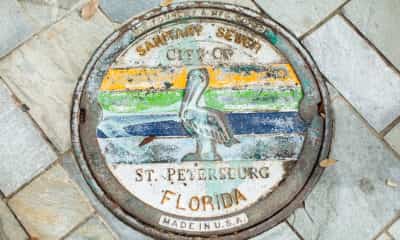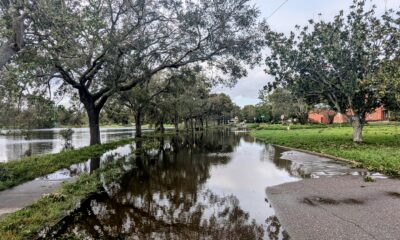Changing tides: Kriseman reflects on progress made since 2015 sewage spill crisis

Several years ago, St. Petersburg faced a 200-million gallon sewage spill crisis and since then, the city has taken momentous steps to ensure that incident will never repeat.
At the Clam Bayou Nature Preserve, a site affected by the sewage discharge in 2015, St. Petersburg Mayor Rick Kriseman alongside other officials spoke Monday morning on the frustrations of the past and how the city has made the system a priority.
In 2015 and 2016, heavy rain led to sewage spills as the city long neglected its wastewater system in restoring parts and updating the tools that could have prevented such spills. Since then, the city has fixed the pipes, visually inspecting them and having an alarm system set up. The improvements also included increasing the filter capacity from 40 million to 85 million gallons per day, adding two deep wells, and rehabbing over 5,000 manholes.
“We haven’t had a single wet weather-related problem in more than two years,” Kriseman said. “We never had a sewage problem, we had a rainwater problem (events pushing rainwater into the sewage system). Quite frankly, science tells us these events are only going to get worse. It may ultimately cost the city $3 billion over the next 20 years.”
The city manages water in four different ways – drinking water, stormwater, wastewater and reclaimed water, which is used for purposes such as watering yards and golf courses.
“More rain led to more overflows, spills, discharges … No matter what was happening elsewhere and in many communities in the area, all eyes were on St. Pete and our aging wastewater system. A system with the compromised capacity and old leaking pipes,” Kriseman recalled. “As a result of what happened, changes were made in the public works department. We hired the right consultants and studied the entire system with data collection and scenario planning.”
Today, the city has an Integrated Water Resources Master Plan.
“While we are proud of our progress, the Deputy Mayor [Kanika Tomalin] made it very clear – we are not done yet. This is not an announcement of mission accomplished. This is an announcement of a mission that is being advanced every single day,” Kriseman said.








Correct the Misconceptions
November 18, 2021at8:18 am
To correct misconceptions….the discharges in 2018-2021 were primarily reclaimed water. The causes of the discharges were mostly reclaimed water distribution line breaks (either from corrosion of joints or from being broken by contractors). Reclaimed water is water that has already been fully treated and distributed for landscape irrigation. Since this water had already passed successfully through a treatment plant, the closure and/or replacement of the Albert Whitted plant had absolutely no impact or bearing on these discharges. Furthermore, the few times there were spills during those years that were actually sewage (not reclaimed water) were because the collection system got clogged by fatbergs (Google it) made of grease and rags. Again, even with the Albert Whitted plant operating, these kinds of spills would have happened anyway because they occurred due to pipe clogging, not due to lack of plant capacity. I am sure that the City is not happy with any discharges, regardless of the cause. However, it is just not true or factual that the 2018-2021 spills listed in the comment above are related in any way to the closing of Albert Whitted.
As for construction of new residential units, the City’s sewer system has the capacity to handle that new growth. The City’s sewer system has an average daily capacity of 56 million gallons per day (MGD), but the City’s current customers only use 34 MGD on average. That means that the City’s existing three sewer plants have, on average, 22 MGD of unused daily capacity to serve tens of thousands of new customers.
Bottom line, the City will always have spills as long as the buried infrastructure is hit by accident during digging activities, the buried pipeline infrastructure is not replaced as it ages, or users flush fats, oils, grease, and flushable wipes into the system. All of these causes of discharges are completely unrelated to Albert Whitted and population growth.
Dorine
November 15, 2021at11:52 pm
So far this year St. Petersburg has spewed 730,514 gallons of raw or partially treated sewage as reported on the city web site and to the FDEP. In 2020 St. Pete spewed 215,542 gallons, in 2019 751,163 gallons, and in 2018 149,150 gallons… all because St. Pete Council was too cheap to refurbish, refit or build a replacement sewage plant when they closed the Albert Whitted plant in 2015 and continue to provide the necessary sewage infrastructure to residents even as they are on a building spree downtown that will further overtax the current sewage infrastructure…